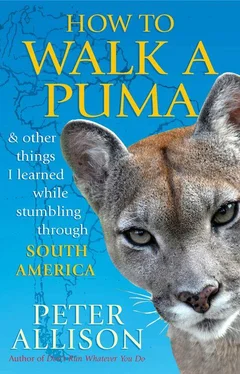Now, hearing this sound coming from under the steps leading to the deck, I knew it was not some lost child, but a baby caiman. They can be quite cute, so I stepped off the deck for a closer look, walking down to the water’s edge. Rookie error, that move.
‘Mom!’ came the sound again, but unlike old Sonko, who was just saying hello, this baby caiman meant exactly what it said.
‘Bugger,’ I thought, just as a wave started coming towards me. I jumped backwards, then sideways, scrambling for the stairs. One of the other tourists staggered away with his hands over his eyes, sure I was about to be eaten, while another gave a strangled croak. Then the guide, who had stepped away for a moment, came back, took in the scene and laughed. He bent down and shone his torch under the deck.
Mom was only about a metre long.
Probably not worth the reaction then.
Based on Gus’s exaggeration of the deck caiman’s size I decided that the black caiman who apparently lived across the lagoon was most likely not the alleged three metres either, and decided to give it no more thought.
•
With my confidence renewed, the next day’s swim was a pleasure, and I started doing one and a half laps. Although I was no longer worried about the caiman, I felt a mild concern about candiru, a fish that makes you understand just how mean a streak evolution possesses. Small and narrow, like half a worm, it usually latches onto the gills of larger fish, lodging itself in with sharpened fins and feeding on the soft flesh inside. Somehow it has also developed a sideline hobby with swimming humans, homing in on the smell of urine before proceeding straight up the urinary tract—this applies to women as well as men. (However, the reputation it has of being able to swim straight up the urinary stream of anyone foolish enough to pee into the river is a myth.) Once inside the urinary tract, the candiru’s barbed fins come out and it eats away, driving the host mad with pain—rumours abound of men performing autopeotomies rather than live with it inside them.
I had been told that candiru were not in the lagoon for the same reason there were no mosquitoes—the water was too acidic. Nevertheless, I was glad for the mesh insert in my swimmers that would act as an extra barrier. I also, as a matter of course, did not pee in the lagoon, something that made me swim faster each time my feet dragged into the cold water below.
One day during my swim I noticed a clump of vegetation that must have broken away from the bank or come in on a channel, and had formed a floating island in the lagoon. About two metres in diameter, it drifted randomly, pushed by wind and what small currents there were in the water, until it came to rest right in the middle of my usual route. I would have to pass right by that, and it perturbed me. Such places are havens for fish, who use them to shelter from dive bombers like kingfishers, and trawlers like terns and skimmers. Unfortunately, it doesn’t save them from predators that they share the water with; in fact, any enterprising caiman would investigate the island to see if it was snack time.
These were not good thoughts to be dwelling on as I approached it, and I swam even more slowly than usual, only spurred on when my feet hit the cold patches. For some reason I started to picture myself doing a similar swim in northern Australia, or back in Botswana, and how terrifying it would be if a scaly head appeared beside me. I couldn’t help imagining the terrifying feeling of jaws clamping on a limb. I started swimming faster, powering past the makeshift island, the urge to have a little pee stronger than ever before, the fear of candiru still sufficient to keep it in. My swimming technique is all enthusiasm, no style (I’m terrified of hearing that I am the same in bed), and now I was really churning the water, sure that something was stalking me, the mysterious black caiman somewhere behind me, closing in.
I began to plan what I would do if I was grabbed. ‘Crocodilians have sensitive skin between their toes,’ a guiding instructor once told me in all seriousness, ‘and a good pinch there might make them release you.’ I couldn’t imagine having the presence of mind to locate this particular patch of skin in such circumstances—in fact I thought it was far more likely I’d panic to death first. A friend of mine in South Africa once had a smallish croc take his arm clean off, not something I wished for but better than being grabbed by the torso and dragged down into the water and drowned. If I was fortunate enough to only lose a limb, my board shorts had a drawstring, and I could rip that out and make a tourniquet, swimming to whatever bank was nearest, making sure to compensate for my lopsidedness as I went.
There was a flaw in my plan though. ‘Bloody piranhas,’ I thought. With that much blood in the water there was no way they would stick with their mainly vegetarian ways.
None of these ideas was comforting in the least, and when I hit my turnaround point I didn’t even pause, just started back, taking a wider route around the sinister vegetation.
Suddenly some nostrils appeared beside me, and kept pace. I made a sobbing wail, a panicky flurry from my legs sending ripples over the animal’s nose and making it disappear, which was even worse than being able to see it.
My mind took a moment to process what I had seen, busy as it was reverting to childhood; then I realised that the nostrils had been tiny, and closely spaced—a reptile to be sure, but no caiman. The nostrils reappeared, then a whole head—that of a terrapin. (‘Tortoises live on land, and have little round feet like elephants,’ I have explained to many a tourist. ‘Turtles live in the ocean and have flippers. Terrapins live in fresh water and have webbed feet.’) ‘You bastard!’ I spluttered in relief. Once my heart rate had returned to normal, I began to enjoy the little reptile’s company alongside me (and I also thought it might act as bait for anything larger that might come along, distracting it from my flailing legs in the water). It tracked with me for a while, and keeping my focus on it rather than the boogey caiman, I was able to enjoy my swim once more, not even flinching too much or squealing when submerged vegetation brushed my leg.
Despite my fears I went back into the lagoon day after day, plunging off the board, swimming out and back, then out and back again, eventually building up to three times across—no great achievement, but after a year on the road it was refreshing to not feel like a piece of cheese.
In Africa I had met and become friends with two well-known wildlife photographers, Pete and Renee, who lived in Ecuador and had introduced me to Sacha’s owners, thus facilitating my stay. During my last few days at Sacha they came to visit the camp and get some photos for their portfolios. I pointed out to them a place where the pygmy marmosets crossed a path within the lodge grounds each day, one of them carrying a thumb-sized baby with an old-man face, then announced that I was off for my daily swim.
‘How far do you go?’ Pete asked.
‘Three times across and back,’ I answered proudly.
‘I wouldn’t,’ Pete said simply. Pete has lived in Ecuador for twenty-five years, and travels the world photographing animals, getting the very first images of certain species in the wild, so when it comes to wildlife he’s someone to listen to.
So I didn’t listen and went out to swim the last few days.
Pete and Renee stayed on at the lodge after I left, and emailed me a few days later. ‘Remember that story we told you about the Peruvian primate researcher?’ they wrote.
I did recall the story. The researcher had disappeared two years earlier while taking his regular swim somewhere in Peru’s Manú National Park. No trace had been found, not a scrap of flesh, not a piece of swimwear. If a caiman had grabbed him or if he had somehow been nabbed from the shore by a jaguar there would have been some grisly evidence, and if he had merely drowned it would have become evident over time when his body appeared. There was only one reasonable suspect.
Читать дальше












